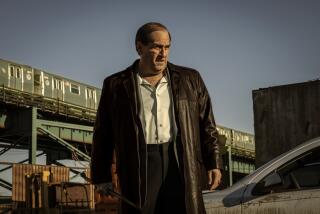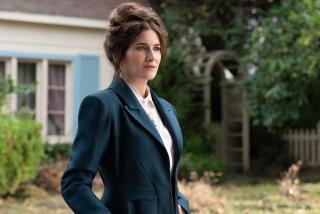How ‘WandaVision’ tailored its episodes to the five stages of grief
- Share via
It’s about a witch and an android living in sitcom suburbia. It’s also about the extremes to which the mind can go to cope with devastating grief. And it’s a testament to the strength of “WandaVision’s” themes and storytelling that the series earned 23 Emmy nominations, including three for writing — more than any other series received this season.
“WandaVision” painstakingly re-creates the worlds of classic sitcoms in which Wanda (Elizabeth Olsen) and Vision (Paul Bettany), two superheroes from the Marvel Cinematic Universe, find themselves — a conceit that could have come off as gimmicky. Director Matt Shakman and showrunner Jac Schaeffer, both Emmy nominees, however, rooted it all in the series’ focus on emotional trauma.
“Jac and I talked about how long could we sustain [the sitcom gag],” Shakman says. “These moments of unease and tension where you could see there was more beneath the surface took more importance as the episodes progressed, leading to the end of the third episode, when it broke open and you saw the world outside.
“There was this emotional throughline pulling it all together. So I felt like the wonderful experimentation would always have a really good, solid structure underneath. It was really just, how long would people have patience for sitcoms?”
“I was nervous,” admits Schaeffer, “but the thing that gave me peace was Wanda and Vision. If they’re truly the heart of the show, and if we love them the way they love each other, then this whole thing will work and it won’t feel like a gimmick.”
The sitcom framing is eventually revealed to be a creation of Wanda’s disoriented mind and her growing powers. It’s a regression to her happy childhood memories, built to deny the reality of Vision’s death, which occurred in the movie “Avengers: Infinity War.” Schaeffer and Shakman used the tropes of classic television to convey the ghosts haunting her machine.
“When Matt joined, the intrigue of the show really got pulled out and enhanced; the way he staged and shot, in the pilot, when [Vision’s boss] chokes and we go in for all of that gorgeous ‘Twilight Zone’ stuff,” Schaeffer says of the chilling moment in the first episode in which the cinematic language abruptly shifts from the live-before-a-studio-audience, no-fourth-wall ’60s sitcom to the eerie, enclosed universe of the iconic Rod Serling anthology series.
“That was the second big, foundational column to the show: It’s the love story and loving these characters, and then it’s this really weirdo ‘Twilight Zone,’ mystery, puzzle box you’re going to want to hang out for,” Schaeffer adds.
Underneath all those bells and whistles, “WandaVision” is an exploration of grief — through superpowered protagonists. Wanda has fashioned this entire television-inspired reality in the town of Westview as a response to trauma, and isn’t even fully aware she has done so. Schaeffer structured the series to conform to the Elisabeth Kübler-Ross model of stages of grief: denial, anger, bargaining, depression and acceptance.
“The writers in my room brought an enormous amount of integrity to the story,” Schaeffer says. “They were able to be hilarious and live in the sitcom space and never lose sight of that grief journey. Everybody was very vulnerable in the room and very willing to share their own experiences. We all collectively treated Wanda with such tenderness and such empathy every day in the room.
“We consulted a grief counselor. There is suppressed trauma [Wanda] doesn’t fully recall. Making the spell that creates her insular sitcom world and all that has to be shown to her, so that’s the denial piece, those first three episodes,” Schaeffer adds.
“When she kicks out Monica [a government agent who has infiltrated Westview], that is her first large expression of anger. She’s got a little one against [Vision’s boss], making him choke, and one against [a neighbor], making her break a glass. But the one that sort of knocks her out of denial is that one with Monica because she ... is confronted with the truth of the scenario” she has created.
Look! Up in the sky! It’s a bunch of quality shows with superheroes in them!
Shakman says Wanda’s fluctuating awareness of her creation of that world offered “not only acting opportunities but design opportunities as well — the way we shot things. Our fifth episode, the ‘Family Ties’ one, is absolutely a bargaining episode. She goes out and confronts [the agents] for the first time, but also confronts Vision for the first time; it leads to this domestic struggle.
“It looks like ‘Family Ties’ and ‘Full House,’ it’s shot like them, but the lighting starts to change. We change our framing. Visual effects have a different language; no longer are they wires and jump cuts and the ‘Bewitched‘-style stuff. That transition from pure sitcom world to Marvel was something we carefully planned out.”
Schaeffer said, “The ‘Modern Family’ episode was always meant to be the depression episode. We thought that that would play well into the tone of the 2000s, 2010s shows — her falling apart and eating, those tropey lady-who-can’t-handle-a-breakup kinds of things, but that’s legitimately what’s going on: standard symptoms of clinical depression.
“Then, of course, everything is ramping toward acceptance at the end, which is the whole point of the show: her acceptance of the truth of her life.”
Our panel of veteran TV journalists predict the 2021 Emmy winners. Take your own shot at it with our online polls.
More to Read
From the Oscars to the Emmys.
Get the Envelope newsletter for exclusive awards season coverage, behind-the-scenes stories from the Envelope podcast and columnist Glenn Whipp’s must-read analysis.
You may occasionally receive promotional content from the Los Angeles Times.











